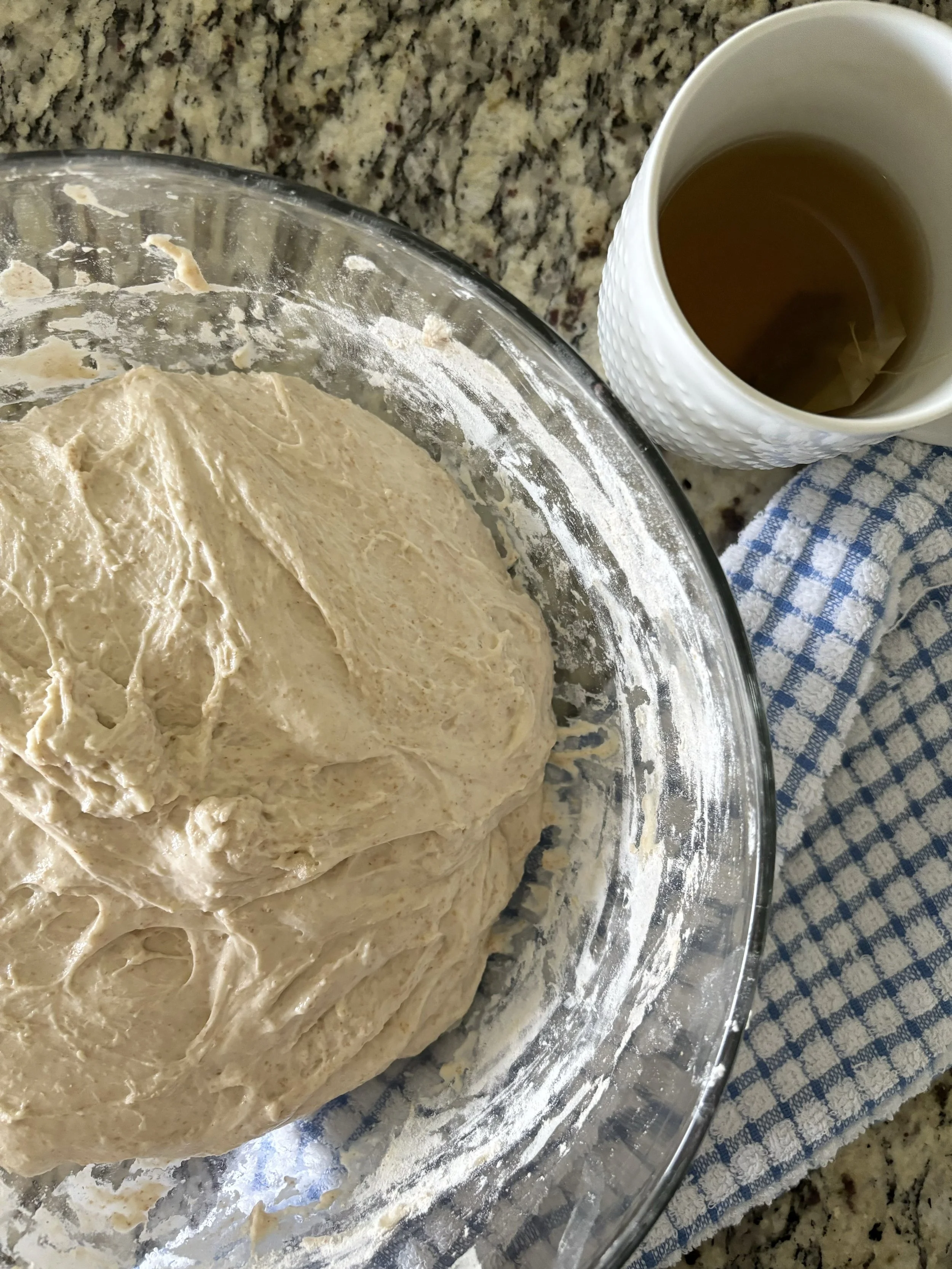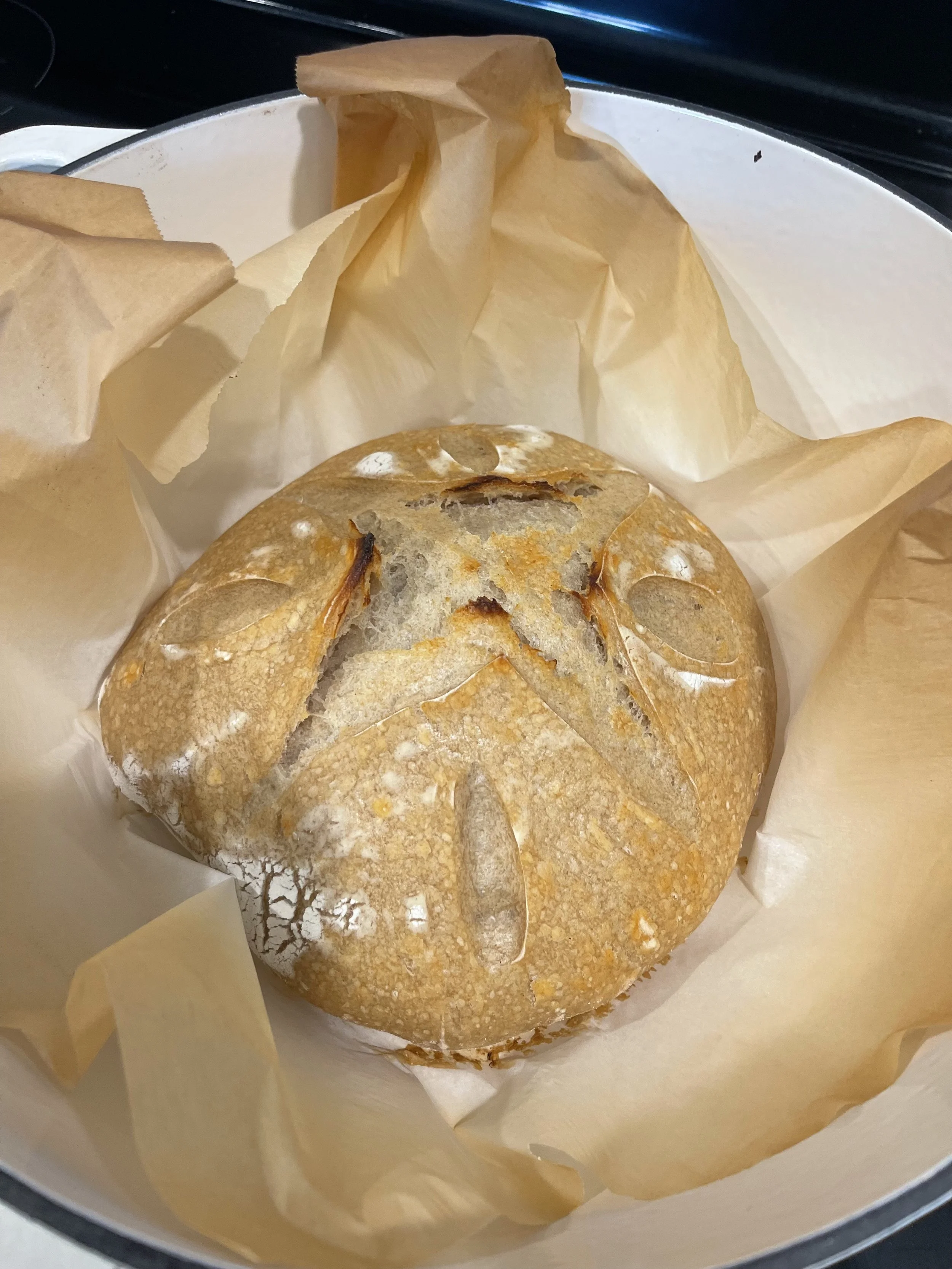Beginners Sourdough Bread
Happy Monday friends!
This morning I was prepping my sourdough which I make about once a week and I thought it would be the perfect day to share my easy, beginner sourdough recipe.
For a little backstory, last summer I wanted to pick up a new hobby but I didn’t know what to do. I started to see sourdough all over Instagram and decided to try my hand at making it and I fell in love with not only the process but the bread too. As someone who is gluten sensitive I was hesitant about making it but decided if I enjoyed making it, at least my family could enjoy it even if I couldn’t. I also did a lot of research that mentioned that those with gluten sensitivities could eat sourdough without any issues and I was hopeful that was the case, thankfully it has been for me and I have loved making and eating it ever since.
Over the last year I have tried many different recipes and I have both made a starter completely from scratch and by dehydrating one I bought and I finally feel like I have the routine and recipe into a good rhythm with simple instructions and simple supplies so I wanted to not only share for you today but have it live on the blog where I can refer back to it myself too.
Before I share the recipe I did want to share supplies that I use so you can grab those too, having what you need is key to making this fun and not overwhelming!
Beginner Sourdough Bread //
Ingredients:
200 g bubble sourdough (it should float when tested in water, if it doesn’t, it isn’t ready)
700 g lukewarm water
900 g white flour
100 g wheat flour
20 g salt
*Note, making sourdough takes a full 3 days from start to finish which sounds intimidating but it isn’t, it is just a process. I recommend working backwards to find your schedule and routine. For instance, if you want bread on Wednesday, you want to start the process on Monday. Be sure to know when you want to eat the bread (if there is a specific day or meal) so you can start feeding your starter and getting ready in time.
Directions:
Day 1: Feed your starter. I like to do a 1:3:3 ratio when feeding my starter, this is where I get the best results but your starter could be different. Remember, it takes time to find the “sweet spot” of feeding so if you haven’t found it yet just keep trying. For me to get started, I use 50g starter with 150 g water and 150 g white flour. Once combined I leave the starter to bubble up and double in size. Every starter takes a different amount of time because everyones starter and home is different but for me, this takes about 12 hours.
Day 2: Once your starter is bubbly and passes the float test (your starter floats in lukewarm water versus sinking to the bottom of the bowl….if it sinks, feed it again and keep waiting until it is ready) you are ready to prep your bread. This recipe should yield 2 loafs of sourdough bread.
In a large mixing bowl placed on top of a food scale, add in 700 g of lukewarm water.
Add to the water, 100 g of bubble starter and mix in well with a dough whisk or fork until bubbly.
Once bubbly, add in the 900 g of white flour, 100 g of wheat flour and 20 g salt.
Mix with a dough whisk or spatula until the water is absorbed and then use your hands (recommend getting them wet) until combined.
Let sit for 1 hour on the counter covered by a tea towel. Recommend placing a towel or hot pad under the bowl as often times the counters are cold due to the AC/weather and this helps regulate the temps a bit better.
At this point you will start your stretch and folds. You want to grab the sides of the dough and pull up as high as you can without breading the dough and fold over. Repeat this process 3 times an hour apart each.
Once you have completed all of your stretch and folds, sprinkle rice flour over your covered banneton and split your dough in half. I recommend doing this over a large cutting board to minimize the mess.
Once the dough is split in 2 even halves, spread the dough out without making holes and fold in half, then in half again creating a rectangle then a square. Next, using your hands form the dough into ball and place into the floured banneton.
Cover the dough (I use fabric covers) and place into the fridge for 12 hours.
Day 3: This is bake day and the best day if I do say so myself!
Preheat your oven to 450 degrees placing your dutch oven inside to preheat with the oven.
Once the oven reaches temperature, lay out a large piece of parchment paper, transfer your dough to the paper (flour side up) and score your bread using your scoring blade or a very sharp knife. I like to score 2 lines in the bread, one to the left and one to the right the length of the ball of the dough and then make small scores along the large score.
Place the dough in the dutch oven and bake with the lid on for 25 minutes.
Remove the lid and bake for another 20 minutes uncovered.
Remove the bread from the dutch oven and place on the counter to cool.
About an hour later you can cut into the bread using a break knife. Recommend slicing the loaf in half and placing the open flat bread side down to slice into smaller pieces easier.
Enjoy with butter, jelly, peanut butter — whatever you prefer! Store in an airtight container for 3-5 days and be really proud of yourself for making bread for your family!
Tips:
When handling the bread, make sure your hands are wet, it will make handling the dough easier because it is so sticky.
If your dough is too runny you need to add more flour to your starter. If it is too thick, you need more water. Sometimes it takes playing with the measurements by 10 and 20 g to get it right for your environment.
Have paper towels handy every step of the way and wipe everything down before washing — this goes doe bowls, spatulas, etc. Sourdough will clog your drains so I recommend wiping everything with a paper towel to throw away before washing to minimize the amount of dough going down your drain.
Use a tulip jar to store your starter. You can leave it in the fridge for months without feeding if it is airtight but only a day or so on the counter before it needs to be fed again. Your starter will get hungry, develop hooch (a grey liquid on the top) and smell like alcohol when it is hungry. Unless you see mold, you are good to throw away all but 25 g and feed it again.
Sourdough can stay in your fridge formed in the banneton for up to 3 days. Since this recipe makes 2 loaves, bake one at a time so you have fresh bread all week long — this is what I do unless I am making the 2nd loaf to give to someone else!
I am not an expert on sourdough and I am definitely not an expert baker but this is the recipe and rhythm that has produced amazing bread for our family to enjoy week after week!
A typical week for me looks like — feeding my starter Monday evening, prepping my bread Tuesday morning and baking on Wednesday morning. Feeding your starter is quick but the day 2 and day 3 processes will require you to be home for a few hours to complete so just keep that in mind.
Happy baking friends!





